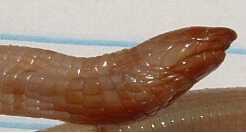Rhineurids facts for kids
Rhineuridae is a family of amazing creatures called worm lizards. Today, only one type of living worm lizard belongs to this family: the Rhineura floridana. Many other types of Rhineuridae used to live on Earth, but they are now extinct.
The Rhineura floridana lives only in Florida, in the southeastern United States. But long ago, other Rhineuridae lived all across North America, even as far west as Oregon! Scientists have found fossils of Rhineuridae that are 60 million years old. This means they have been around since the Paleocene epoch. They were most common in the middle of North America during the Eocene and Oligocene epochs.
Quick facts for kids Rhineurids |
|
|---|---|
 |
|
| Rhineura floridana | |
| Scientific classification |
|
| Kingdom: | Animalia |
| Phylum: | Chordata |
| Class: | Reptilia |
| Order: | Squamata |
| Clade: | Amphisbaenia |
| Family: | Rhineuridae Vanzolini, 1951 |
| Genera | |
|
†Archaerhineura |
|
Contents
Discovering Ancient Worm Lizards
The oldest known rhineurid is called Plesiorhineura tsentasai. Its fossils are from the Early Paleocene, almost 60 million years ago. We only have a piece of its jaw, but it looks a lot like modern rhineurids.
Shovel-Snouted Survivors
Many Eocene rhineurids, like Spathorhynchus fossorium, look very much like the Rhineura we see today. This shows that these animals have not changed much over millions of years. Unlike some other worm lizards that have round or keeled heads, all fossil rhineurids found so far have a special "shovel-snouted" head. This shape helps them dig through the soil.
Where They Lived
Fossil rhineurids have only been found in North America. But they used to live in many more places than the Rhineura floridana does now. Their fossils have been found in Colorado, Wyoming, South Dakota, Montana, and even Oregon. This wide range suggests that the climate was much warmer in the past. When rhineurids first spread across North America, most of the continent was warm and humid.
Rhineurids survived a big climate change when North America became drier and covered in savannas. However, their numbers started to drop when the Earth suddenly became cooler during the Middle Miocene disruption. As global temperatures continued to fall, the areas where rhineurids could live shrank. This left Rhineura floridana isolated in Florida as the only living member of its group.
Uncovering Their Family Tree
In 2007, a scientist named Daniel Hembree studied all the fossil worm lizards found in North America. He discovered that all of them belonged to the Rhineuridae family. He also found that many species that scientists had named before were actually the same as older species. This meant there were fewer different types of rhineurids than once thought.
For example, several species like Jepsibaena minor and Rhineura amblyceps were found to be the same as Protorhineurna hatchetii. This left Rhineura floridana as the only species in the Rhineura group. Before this study, paleontologists often named new species from just small pieces of fossils. These pieces sometimes did not have enough details to show if they were truly different species. Hembree's work helped us understand that the diversity of rhineurids in North America was lower than we thought.
Family Connections
Daniel Hembree's study also looked at how rhineurids are related to other worm lizards. He found that Rhineura floridana is the most "basal" species in the family. This means its lineage was one of the first to branch off from the main group. However, the Rhineura floridana itself is a relatively new species, with its oldest fossils found in Florida from the Pleistocene epoch. Scientists believe that the ancestors of Rhineura floridana probably moved into what is now Florida from the middle of the continent. The other rhineurids stayed in the continental interior, where they continued to develop into different species.
See also
 In Spanish: Rhineuridae para niños
In Spanish: Rhineuridae para niños

